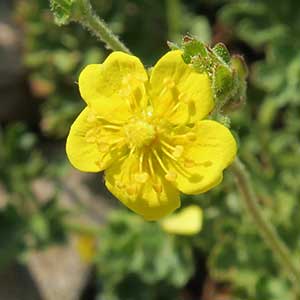|
short-leaf cinquefoil, sparse-leaf cinquefoil
|
sagebrush cinquefoil
|
|
0.4–2 dm, lengths 2 times basal leaves. |
petiole 1–4 cm, eglandular hairs absent or sparse, spreading, less than 1 mm, weak, glands abundant. |
palmate, 3–8(–13) cm; petiole 1.5–5(–8) cm, straight hairs abundant, ± appressed, 1–2 mm, stiff, cottony hairs absent, glands sparse to abundant; leaflets (3–)5–7(–9), on tip or at least less than distal 1/10 of leaf axis, separate to slightly overlapping, proximal pair separated from others by 0–1 mm of leaf axis, central leaflets narrowly cuneate to oblanceolate, 1–3(–4) × 0.3–0.7 cm, petiolule 1 mm, distal 1/4 or less of margins incised 1/3–2/3 to midvein, teeth 1(–3) per side, separate, 1–2(–4) mm, surfaces similar, green to grayish, straight hairs sparse to common, appressed, 1–1.5(–2) mm, stiff (sometimes softer and wavy), cottony hairs absent, glands sparse to abundant. |
|
4–11-flowered. |
|
0.7–2(–4) cm. |
epicalyx bractlets lanceolate-elliptic to ovate, 2–4 × 0.8–2 mm; sepals 3–5(–7) mm, apex broadly acute to obtuse; petals 3.5–6.5 × 3–5 mm; filaments 1–2.5 mm, anthers 0.5–0.6 mm; carpels 10–15. |
epicalyx bractlets ± lanceolate, 2–4 × 1 mm; hypanthium 3–4(–6) mm diam.; sepals 3–4.5 mm, apex acute to obtuse; petals 5–7 × 3–5 mm; filaments 1–2.5 mm, anthers 0.6–0.8 mm; carpels 3–10, styles 2–2.5 mm. |
1–1.5 mm. |
2.5 mm, smooth to slightly rugose. |
|
|
|
|
| Flowering summer. |
Flowering summer. |
| Moist rocky slopes and talus, alpine grassy areas, subalpine conifer woodlands |
Rocky slopes in pinyon-juniper woodlands, with Artemisia |
| 2500–3600 m (8200–11800 ft) |
2300–2500 m (7500–8200 ft) |
|
ID; MT; NV; OR; WY
|
NV |
Potentilla brevifolia is found mainly in alpine situations in the Pioneer, Sawtooth, Smoky, and White Cloud mountains of central Idaho; the Madison Range of western Montana; the Jarbidge Range of northeastern Nevada; the Blue, Steens, and Wallowa mountains of eastern Oregon; and the Teton Range of northwestern Wyoming. The elongate caudices are easily covered by moving soil and talus. (Discussion copyrighted by Flora of North America; reprinted with permission.) |
Of conservation concern. Potentilla johnstonii occurs only in the Quinn Canyon Range in Nye County. Its distinctiveness was first noted by B. C. Johnston (1980), who treated it as a variety of P. concinna using the unpublished epithet curvata. (Discussion copyrighted by Flora of North America; reprinted with permission.) |
| FNA vol. 9, p. 188. |
FNA vol. 9, p. 182. |
| Rosaceae > subfam. Rosoideae > tribe Potentilleae > Potentilla > sect. Brevifoliae |
Rosaceae > subfam. Rosoideae > tribe Potentilleae > Potentilla > sect. Concinnae |
P. albiflora, P. ambigens, P. anachoretica, P. angelliae, P. anglica, P. anserina, P. arenosa, P. argentea, P. arizonica, P. basaltica, P. bicrenata, P. biennis, P. biflora, P. bimundorum, P. bipinnatifida, P. breweri, P. bruceae, P. brunnescens, P. canadensis, P. concinna, P. cottamii, P. crantzii, P. crebridens, P. crinita, P. cristae, P. demotica, P. drummondii, P. effusa, P. elegans, P. erecta, P. flabellifolia, P. fragiformis, P. furcata, P. glaucophylla, P. gracilis, P. grayi, P. hickmanii, P. hippiana, P. holmgrenii, P. hookeriana, P. hyparctica, P. inclinata, P. intermedia, P. jepsonii, P. johnstonii, P. lasiodonta, P. litoralis, P. macounii, P. millefolia, P. modesta, P. morefieldii, P. multijuga, P. multisecta, P. nana, P. newberryi, P. nivea, P. norvegica, P. ovina, P. paucijuga, P. pedersenii, P. pensylvanica, P. plattensis, P. pseudosericea, P. pulchella, P. pulcherrima, P. recta, P. reptans, P. rhyolitica, P. rimicola, P. rivalis, P. robbinsiana, P. rubella, P. rubricaulis, P. sanguinea, P. saximontana, P. sierrae-blancae, P. simplex, P. sterilis, P. stipularis, P. subgorodkovii, P. subjuga, P. subvahliana, P. subviscosa, P. supina, P. thurberi, P. thuringiaca, P. tikhomirovii, P. townsendii, P. uliginosa, P. uschakovii, P. vahliana, P. verna, P. versicolor, P. villosa, P. villosula, P. vulcanicola, P. wheeleri |
P. albiflora, P. ambigens, P. anachoretica, P. angelliae, P. anglica, P. anserina, P. arenosa, P. argentea, P. arizonica, P. basaltica, P. bicrenata, P. biennis, P. biflora, P. bimundorum, P. bipinnatifida, P. brevifolia, P. breweri, P. bruceae, P. brunnescens, P. canadensis, P. concinna, P. cottamii, P. crantzii, P. crebridens, P. crinita, P. cristae, P. demotica, P. drummondii, P. effusa, P. elegans, P. erecta, P. flabellifolia, P. fragiformis, P. furcata, P. glaucophylla, P. gracilis, P. grayi, P. hickmanii, P. hippiana, P. holmgrenii, P. hookeriana, P. hyparctica, P. inclinata, P. intermedia, P. jepsonii, P. lasiodonta, P. litoralis, P. macounii, P. millefolia, P. modesta, P. morefieldii, P. multijuga, P. multisecta, P. nana, P. newberryi, P. nivea, P. norvegica, P. ovina, P. paucijuga, P. pedersenii, P. pensylvanica, P. plattensis, P. pseudosericea, P. pulchella, P. pulcherrima, P. recta, P. reptans, P. rhyolitica, P. rimicola, P. rivalis, P. robbinsiana, P. rubella, P. rubricaulis, P. sanguinea, P. saximontana, P. sierrae-blancae, P. simplex, P. sterilis, P. stipularis, P. subgorodkovii, P. subjuga, P. subvahliana, P. subviscosa, P. supina, P. thurberi, P. thuringiaca, P. tikhomirovii, P. townsendii, P. uliginosa, P. uschakovii, P. vahliana, P. verna, P. versicolor, P. villosa, P. villosula, P. vulcanicola, P. wheeleri |
| Nuttall: in J. Torrey and A. Gray, Fl. N. Amer. 1: 442. (1840) |
Soják: Thaiszia 16: 97. (2007) |
| |


